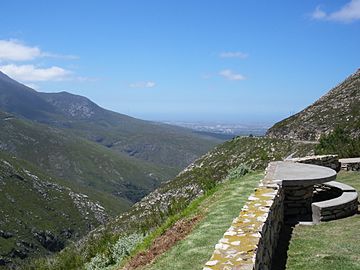Outeniqua Mountains facts for kids
Quick facts for kids Outeniqua Mountains |
|
|---|---|

Outeniqua Pass
|
|
| Highest point | |
| Peak | Cradock Peak |
| Elevation | 1,578 m (5,177 ft) |
| Geography | |
| Country | South Africa |
| Province | Western Cape |
The Outeniqua Mountains are a beautiful mountain range in South Africa. They run along the southern coast of the country. These mountains got their name from the Outeniqua Khoikhoi people. The Khoikhoi were a group of people who lived in this area a long time ago.
These mountains are connected to other ranges. To the west, they join the Langeberg mountains. To the east, they connect with the Tsitsikamma Mountains. Together, they form a long chain of mountains. Long ago, Portuguese explorers called these mountains "Serra de Estrella." This means "Mountain of the Star." The Outeniqua Mountains are also a big part of South Africa's famous Garden Route.
Contents
Exploring the Outeniqua Mountains
The Outeniqua Mountains stretch across the Western Cape province. They are an important natural feature of the region. These mountains help shape the landscape and climate.
Highest Point and Location
The tallest part of the Outeniqua Mountains is called Cradock Peak. This peak stands very high, reaching about 1,578 meters (5,177 feet) above sea level. The mountains generally run from east to west. They create a natural barrier between the drier inland areas and the wetter coastal strip.
The Garden Route Connection
The Outeniqua Mountains are a key part of the Garden Route. This is a popular tourist area known for its green forests and beautiful coastline. The mountains add to the stunning scenery of this route. They offer amazing views and outdoor activities.
Climate and Environment
The Outeniqua Mountains play a big role in the local weather. They block moisture-filled air coming from the ocean. This causes rain to fall on the coastal side of the mountains.
Unique Plant Life
The mountain slopes are home to a special type of plant life. This is called fynbos. Fynbos is a unique kind of shrubland found only in the Western Cape. It has many different types of plants. Some of these plants are found nowhere else in the world.
Animal Life
Many animals also live in the Outeniqua Mountains. You might find different kinds of birds, small mammals, and reptiles. The varied habitats, from forests to fynbos, support a wide range of wildlife. Protecting these areas helps keep these animals safe.
Passes and Pathways
Several mountain passes cross the Outeniqua Mountains. These passes connect the coast with the inland regions. They are important for travel and trade.
Outeniqua Pass
One of the most famous passes is the Outeniqua Pass. This road winds through the mountains. It offers incredible views of the surrounding landscape. The pass is a vital link for people and goods moving through the area. It is also a popular route for tourists.
Historical Railways
In the past, a famous steam train called the "Outeniqua Choo-Tjoe" used to run here. It traveled along the coast and through parts of the mountains. This train was a popular way to see the beautiful scenery. While the full service no longer runs, the history of the railway is still important.
Importance of the Mountains
The Outeniqua Mountains are more than just a pretty sight. They are important for several reasons.
Water Source
The mountains act like a giant sponge. They collect rainfall, which then flows into rivers and streams. These waterways provide fresh water for towns and farms in the region. This makes the mountains vital for life in the area.
Tourism and Recreation
The mountains attract many visitors. People come to hike, cycle, and enjoy nature. There are many trails and viewpoints. These activities help the local economy. They also allow people to connect with nature.
Protecting Nature
Efforts are made to protect the natural beauty and wildlife of the Outeniqua Mountains. Conservation projects help keep the fynbos healthy. They also protect the animals that call these mountains home. This ensures that future generations can also enjoy this special place.


